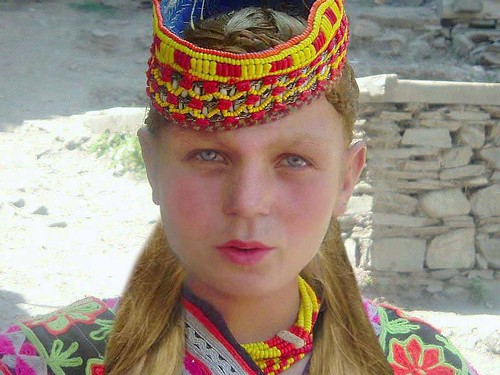In a 2005 study of ASPM gene variants, Mekel-Bobrov et al. found that the Kalash people of Pakistan have among the highest rate of the newly-evolved ASPM haplogroup D, at 60% occurrence of the approximately 6,000-year-old allele.[31]
The Kalash also have been shown to exhibit the exceedingly rare 19 allele value at autosomal marker D9S1120 at a frequency higher than the majority of other world populations which do have it.[32]
Firasat et al. (2006) conclude that the Kalash lack typical Greek haplogroups (e.g. haplogroup 21),[33] On the other hand, a study by Qamar et al. (2002) found that even though "no support for a Greek origin of their Y chromosomes was found" in the Kalash, Greek y-chromosome admixture could be as high as 20% to 40%.[34] Considering the apparent absence of haplogroup 21 in the local population, one of the possibilities suggested was because of genetic drift.[34] On the basis of Y chromosome allele frequency, some researchers describe the exact Greek contribution to Kalash as unclear.[35]
Another study with Qasim Ayub, and S. Qasim Mehdi, and led by Quintana-Murci claims that "the western Eurasian presence in the Kalash population reaches a frequency of 100%, the most prevalent [mtDNA] haplogroup being U4, (pre-HV)1, U2e, and J2," and that they show "no detectable East or South Asian lineages. The outlying genetic position is seen in all analyses. Moreover, although this population is composed of western Eurasian lineages, the most prevalent ... are rare or absent in the surrounding populations and usually characterize populations from Eastern Europe, the middle East and the Caucasus... All these observations bear witness to the strong effects of genetic drift of the Kalash population... However, a western Eurasian origin for this population is likely, in view of their maternal lineages, which can ultimately be traced back to the Middle East".[36]
The estimates by Qamar et al. of Greek admixture has been dismissed by Toomas Kivisild et al. (2003): “some admixture models and programs that exist are not always adequate and realistic estimators of gene flow between populations ... this is particularly the case when markers are used that do not have enough restrictive power to determine the source populations ... or when there are more than two parental populations. In that case, a simplistic model using two parental populations would show a bias towards overestimating admixture”.[37]
The study came to the conclusion that the Pakistani Kalash population estimate by (Qamar et al. 2002) “is unrealistic and is likely also driven by the low marker resolution that pooled southern and western Asian–specific Y-chromosome haplogroup H together with European-specific haplogroup I, into an uninformative polyphyletic cluster 2”.[37]
A study by Rosenberg et al. (2006) employing genetic testing among the Kalash population concluded that they are, in fact, a distinct (and perhaps aboriginal) population with only minor contributions from outside peoples. In one cluster analysis with (K = 7), the Kalash formed one cluster, the others being Africans, Europeans, Middle Easterners, South Asians, East Asians, Melanesians, and Native Americans. [38]
A genetic study published led by Firasat (2007) on Kalash individuals found high and diverse frequencies of :Haplogroup L3a (22.7%), H1* (20.5%), R1a (18.2%), G (18.2%), J2 (9.1%), R* (6.8%), R1* (2.3%), and L* (2.3%).[39] Haplogroup L originates from prehistoric South Asia.[40]
In the recent study: "Worldwide Human Relationships Inferred from Genome-Wide Patterns of Variation (2008)", geneticists using more than 650,000 single nucleotide polymorphisms (SNP) samples from the Human Genome Diversity Panel, found deep rooted lineages that could be distinguished in the Kalash. The results showed them not only to be distinct, but perfectly clustered within the Central/South Asian populations at (K = 7). The study also showed the Kalash to be a separated group, with having no membership within European populations.[41]
























